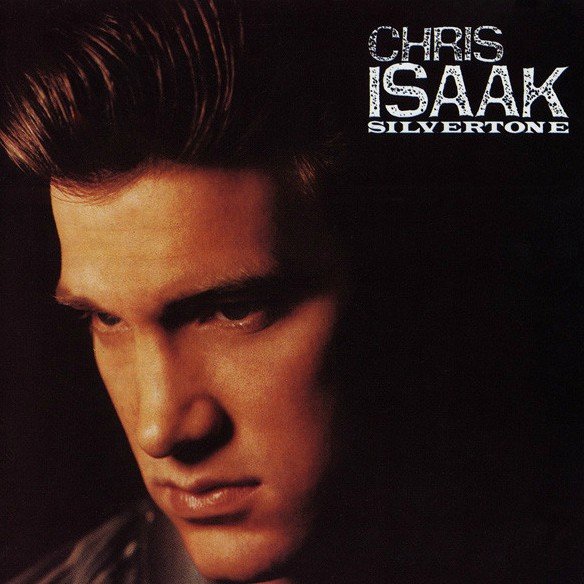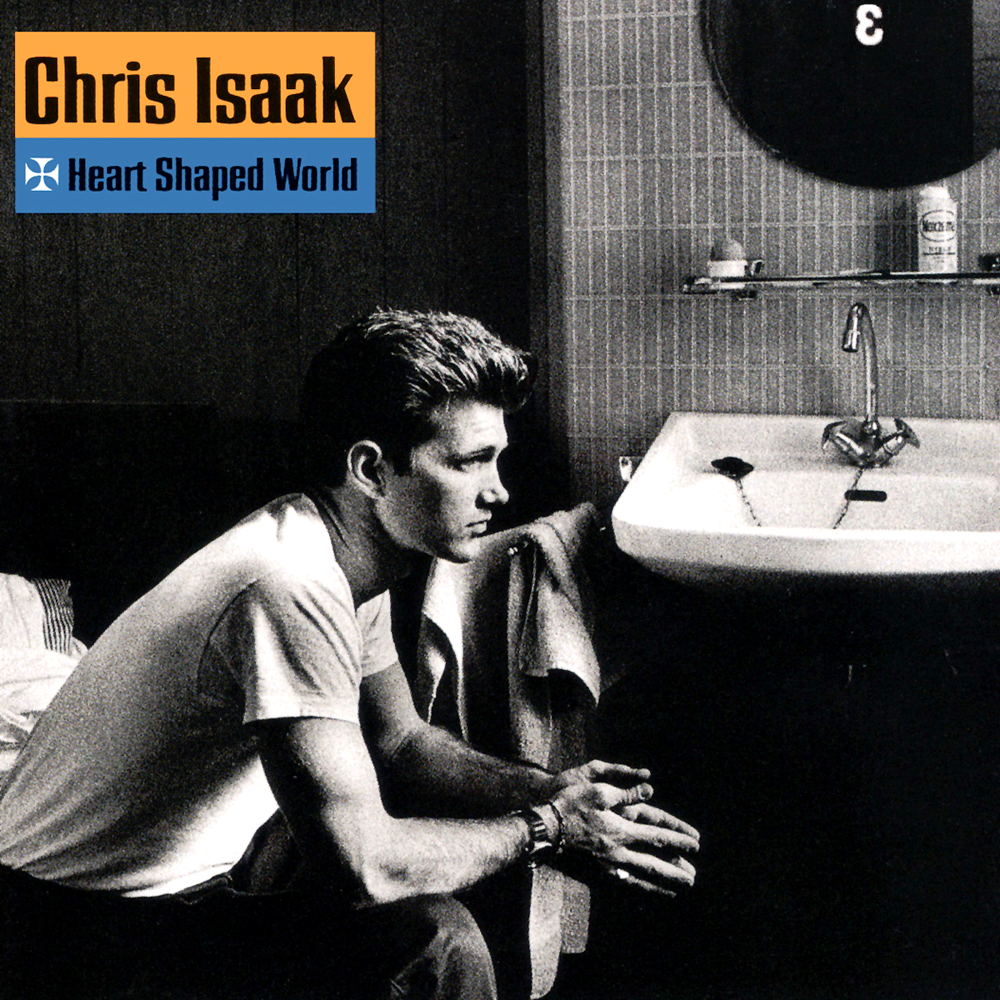Happy 30th Anniversary to Chris Isaak’s fourth studio album ‘San Francisco Days,’ originally released April 13, 1993
I met Chris Isaak for the first time in the summer of 2002 after a headlining show he played on Pier 62/63 in Seattle. Shortly after they’d left the stage, he and his stalwart Silvertone bandmates emerged, chatting and signing autographs (there were no selfies to speak of back then) until every last fan who desired it had something in their hands freshly inked.
When I’d finally made my way to Isaak, I handed him the glossy 8x10 press shot I’d bought at the merch table and, with all the composure I could muster, complimented him on the fact that he and the band were so approachable.
“Oh. Well, that’s court ordered,” he retorted without missing a beat. He’s just as handsome in person, by the way, as he is in every single one of the moody, shadowed profile shots that adorn his album covers—chisel-chinned and steel-eyed, and impossibly debonair in a yellow-hued Hawaiian shirt. He grinned up at me as he drew a halo above his photographed head with a black Sharpie marker.
Isaak’s whip-smart sense of humor is one of the major reasons why he’s able to wear his persona as a mid-century modern renaissance man so comfortably. Or, more accurately, his ability to fully and sincerely commit to his craft without taking himself too seriously. Not twenty minutes before he and I had our brief exchange, he was standing in a flood of spotlights in a suit made almost entirely of mirrors, firing out witty quips to the audience with dagger-like precision.
What I love most about Isaak, however, is his voice and its emotional capacity—magnificently somber and reflective one minute like a rainy windowpane personified, and howling skyward with palpable braggadocio the next. He can match Orbison’s ethereal warble and smolder like Presley effortlessly, which his critics were all-too-eager to shrug off as pastiche when his debut Silvertone arrived in 1985. But anyone who’s given Isaak’s catalog more than a few minutes of attention would likely agree that he’s cultivated a trademark timbre that’s now more identifiable as his own rather than a facsimile of his influences. No matter how you boil it down, his voice is a remarkable instrument.
If 1989’s Heart Shaped World and the astute sex appeal of its ubiquitous second single and his lone career top-ten hit “Wicked Game” was the tipping point for Isaak’s commercial cachet, 1993’s San Francisco Days was equally critical as a turning point for his evolution as an artist. As a complete entity, San Francisco Days feels more cohesive and organic than its predecessors, which is not to discount any of his previous albums as being less earnest or inferiorly crafted. But the twelve tracks, curated by Isaak’s long-time producer and industry veteran Erik Jacobsen (The Charlatans, Lovin’ Spoonful, Norman Greenbaum, The Tazmanian Devils) seemed to be sketched with more refinement and a new level of compositional confidence and creative license.
Listen to the Album & Watch the Official Videos (Playlist):
"I kind of set out to make this one a little bit different," Isaak said of the album in a 1993 Rolling Stone interview. "People did say that the other albums were very similar. But I've always felt like I had something legitimate to say with that style. Otherwise it would be like a painter saying, 'I already used blue in my early paintings, so I'm not using it anymore.' Still, I always want to learn some new tricks."
The recording sessions for San Francisco Days began in 1990 at Fantasy Studios in Berkeley, California, but were eventually thwarted by the sudden, unexpected interest in “Wicked Game” after an instrumental version of the then-unassuming Heart Shaped World album cut surfaced in David Lynch’s film WIld At Heart. Before long, the vocal version began spinning regularly on radio stations across the country, urging Isaak’s label, Reprise, to issue a single that would quickly find its way into the top ten on Billboard’s Hot 100. Isaak left the studio and his next album in limbo as he went on the road to cash in on his long-awaited smash.
"It was like having the laundry call and say, 'We found a lottery ticket in your jacket, and oh, by the way, it's a winning number,’” Isaak recalled to Musician magazine in 1993. “You know what I mean? You weren't even thinking about whether you were gonna win or lose at that point. I was worrying about the next record."
The mid-stream pause, according to Jacobsen, was inconvenient, “but the big hit after 10 years of trying—to be interrupted with that was something we felt we could put up with,” he told Musician. “Actually it was great, because then there were a lot of expectations on us for the next record, and to have six great tunes already in our hip pocket gave us a real feeling of complacency." Recording was eventually completed in January 1993.
San Francisco Days opens with its folk-infused title track, a showcase for Isaak’s silky baritone as it flirts with an acoustic guitar, bass, and brushed drums, not to mention the playful flourishes of juke joint piano bubbling up under the rhythm section. Isaak’s narrative is nearly storybook-like, evoking tangible images of his adopted hometown as the song builds gently in intensity—so much so you can practically smell the salt coming off Baker Beach. It’s beautifully produced and has unsurprisingly become one of his most enduring songs.
“Beautiful Homes” bumps the tempo up significantly, revisiting the melancholic rockabilly soul that comprised much of Heart Shaped World, driven by a yelping electric guitar lead as Isaak croons about “beautiful houses / with beautiful gardens / where beautiful dreams have died.” “Round N’ Round” gives a nod over its shoulder to the surlier grit of “Voodoo” from Silvertone, and a look ahead at some of the territory he’d explore further on 1995’s Forever Blue. It’s fun to hear Isaak mess things up a little with his band and let out the occasional yowl—a frolicsome dynamic that has also translated well into his live shows over the years.
“Two Hearts” is a gorgeous ballad, beginning with a lone acoustic guitar and Isaak seemingly in almost breathless lament over its protagonist: “no stars in the sky / the night seems so dark around you / you won’t say a word / and you wonder why no-one’s found you waiting for love / praying for love again.” Forty seconds in, a rim click sends the song into an undulating two-step shuffle with tasty little ribbons of a Hammond B3 whisked in, transforming itself into a love letter with Isaak pleading to his subject: “love’s a heavy weight / give it to me, don’t hesitate.” “Except The New Girl” is another example of Isaak flipping the script lyrically as the storyline progresses, with its lead character finding lasting love and fulfillment after it had initially eluded him.
Enjoying this article? Click/tap on the album covers to explore more about Chris Isaak:
"It's a very positive song," Isaak told Harper’s Bazaar in 1993. "It's about somebody who does find somebody. A lot of people seem like they never will: They're too strange, or they're not beautiful...But it's wonderful when you see some guy who's five-foot-two and ugly as a mud fence and he's got a girlfriend. She may be nothing to look at, but you can tell by way the two of them look at each other that they're in love. And if it can happen for them, it can happen for me.”
The album’s first single, “Can’t Do A Thing (To Stop Me),” has often been billed as a successor to “Wicked Game,” and Isaak’s smoky head-voiced lead and the languishing wails of electric guitar in its foreground do fairly justify the comparisons on the surface. But where “Wicked Game” dripped sexual tension in its slow, deliberate pulse, “Can’t Do A Thing…”’s steam is driven by its jazz-spiked hi-hat-and-rim-click rhythm and the constant din of a compressed B3 in the background. It feels a bit more back-alley-at-night than sandy-beach-with-supermodel, but it has an urgency that’s so compelling.
“It's about when you're thinking about being with somebody who's not there,” Isaak said of the song in a 1993 Los Angeles Times interview. “It's like the old line about looking through a store window at a brand new Corvette. Well, you can't stop me from looking at it. It's like you're not with somebody but you can't stop me from thinking about them. To think about being with them, that's all you have sometimes.”
The Hammond gets switched out temporarily for tremolo on the slow burning “Waiting,” which is as close to a torch song as you’ll find on this record. But its beauty is in its simplicity, and the subtle echoes of the refrain in the background give it dimension. “Move Along” picks things up just a little with a bit of a jazzy thump and chugging rhythm guitars, ending in a burst of scratchy organ ad libs as it fades. “I Want Your Love” moves into surf anthem territory, but the rapid-fire bridges with Isaak at full voice and the smear of Jimmy Pugh’s keys in the outro are a welcome contrast.
"The organ is the king of instruments," Isaak insists in Billboard. "Instead of allowing the organ to just be in the background, I brought it in first and then I'd be like, 'Christ, why do I have to put a guitar with it?'"
“5:15” is probably the album’s most restrained track—a bluesy shuffle that keeps Isaak at a near-whisper. But underneath the hushed rhythm guitar and bass, listen for the plucked six-string arpeggios that creep in, and the subtle horn crescendos near the end that emulate a passing train horn. Jacobsen deserves kudos for ensuring those little special details made it in the mix. It’s the kind of stuff designed for the listener to discover upon repeated plays, and I can assure you that a good set of headphones will do this record a significant amount of justice.
The album closes with a relatively faithful, but soulfully satisfying, reading of Neil Diamond’s 1966 debut single, “Solitary Man,” a likely acknowledgement of Isaak’s own introversion out of the public eye in stark contrast to his gregariousness on stage. “You know, I just don’t have that much contact with other people,” he told France’s M6 network in a 1993 interview. “Day-to-day, I spend most of my time on my own. In my house, I live by myself. What I like to do, I do by myself. I like surfing and I surf on my own.”
San Francisco Days’ production is exquisite—a delicious mélange of influences that could very well have been released last week and fit in snugly among the ever-growing revivification of vintage Americana tuneage that’s now permeating popular consciousness. But in 1993, Isaak was still considered an outlier. And for those of us who have always felt somewhat left of center in our musical and personal eclecticism, his unabashed embrace of the anti-hip made him a relatable hero. "I love the idea of people who are misfits, people who have their own fashion,” Isaak affirmed to Billboard. “They're wearing the wrong color bellbottoms, their girlfriend has the wrong hairstyle, but the guy's going, 'Dig me. I'm with Marilyn Monroe,' and she's going, 'I'm with Tony Curtis.'"
Listen:
Editor's note: this anniversary tribute was originally published in 2018 and has since been edited for accuracy and timeliness.



